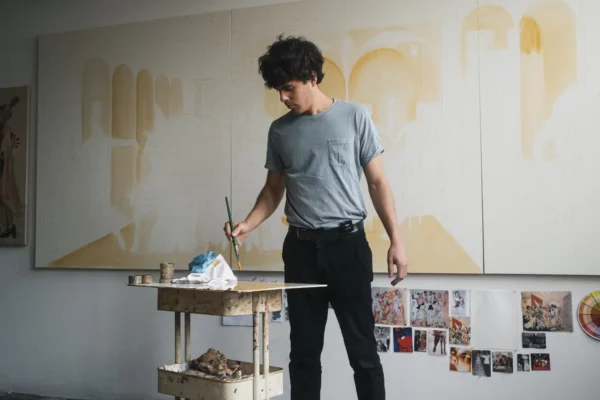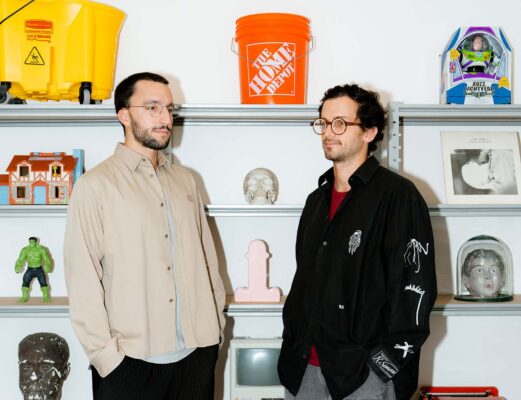
Olivia Villanti, founder of Chava Studio, working from her atelier in Mexico City.
COFFEE WITH
OLIVIA VILLANTI: “THERE IS SOMETHING ARCHITECTURAL ABOUT THE BUILDING OF A GARMENT”
Name: Olivia Villanti
Profession: Designer
Nationality: United States
Zodiac sign: Virgo
Instagram: @oliviavillanti
LATINNESS: Olivia, we’ve never talked about this, but I’m curious about your upbringing. Were you raised in a creative environment?
OLIVIA: Kind of. My parents were both educators. My mom is a special education/early learning teacher, and my dad eventually became a superintendent. They were both really good about helping me cultivate interest.
In Rhinebeck, New York, in the Hudson Valley, where I grew up, the vibe was really creative and a little hippy. It’s in close proximity to Woodstock, and very close to Bard College, which has a really strong program for arts. I took all sorts of classes when I was a kid because they were just abundant. Bard always had summer programs for kids, and I would take photography, drawing and painting classes, and I did a lot of theater and musical theater, dance, etc.
All of those things were really part of the culture where I grew up, and I feel like that probably had a large impact on me.
My mother is an incredible writer and a very creative person. I don’t know if she would really describe herself that way, but she really values creativity and so does my father. I think when they saw that I had a lot of interest, they supported me and were ready to help me find different ways to explore it.
LATINNESS: Do you remember your first brush with fashion?
OLIVIA: You know the one thing that I will say about where I grew up is that it was not fashionable, and I didn’t get very much exposure to fashion. Fashion felt incredibly intimidating and unattainable to me, just in terms of an industry it just felt so abstract.
I was listening to an interview with Imran (Ahmad) from Business of Fashion, though, and he was saying you should look back at what you used to do when you were a child, and it gives you clues into where you’re going to end up in later life. I think about what I used to do as a kid, and I’ve always had an anxious personality. A lot of my energy is in my head, and when I would go to sleep at night, even when I was young, I would get nervous or feel triggered by something, I escaped into this world of imagining things that could exist that I would wear, and it was always around clothing or around color.
When I was in sixth grade, I had like $200 to my name, a gift from my grandmother or something, and I spent $50 on a man’s tie to wear on the first day of school. It doesn’t necessarily mean that I was making super interesting or tasteful style choices, but I did really find that I was interested in it and I felt very empowered.
I’ve always been reserved, a shy personality, and I felt very seen, especially as I started in my adolescence and in high school, when I started playing with clothes. I was completely eclectic. I would wear my brother’s basketball jerseys with jeans, or a really crisp Oxford with dark denim. I was all over the place, but I loved that.
I would scrapbook a lot when I was a kid, and I remember when Marc by Marc Jacobs had just launched, I was obsessed with all that imagery. It touched my heart. The way he used color, these kind of muted pastels, cap sleeve t-shirts and puff sleeve dresses, those little baby doll dresses he used to do with these swingy shapes. It was Marc by Marc Jacobs, not Marc Jacobs, but the lower, more accessible line, which kind of merged grunge, and everyone was in Converse. It just spoke to me.
I definitely was a product of the 90s culture that I lived in, without necessarily connecting the dots that this could potentially become something I did for a living.
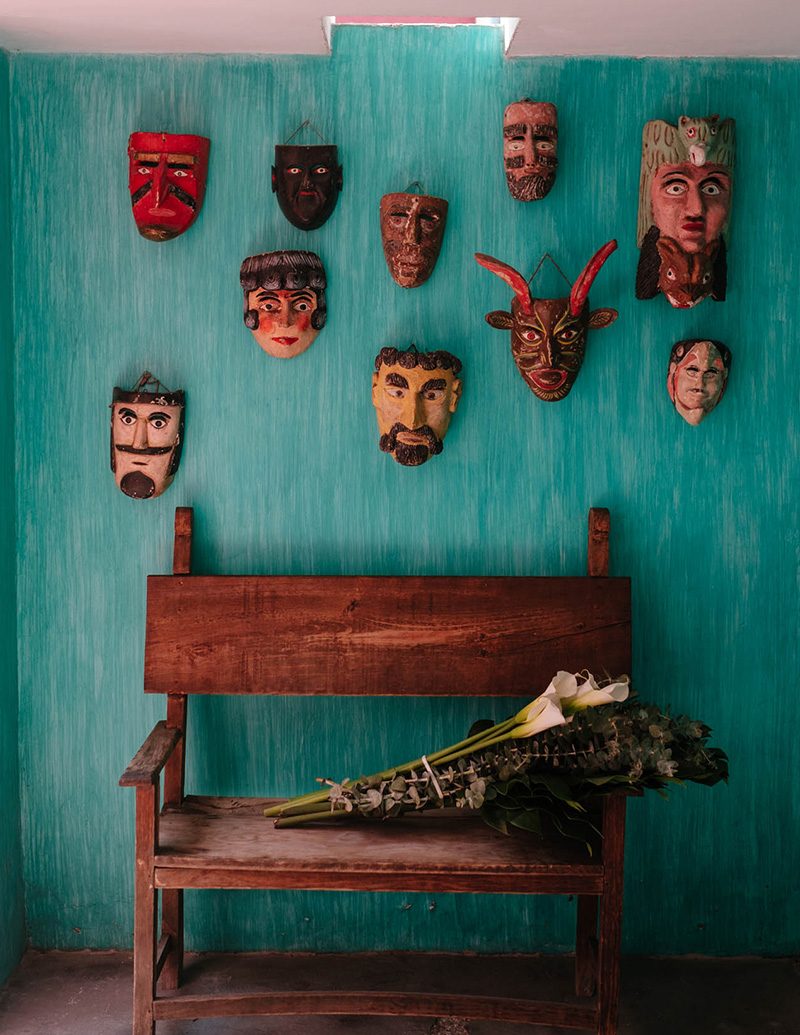
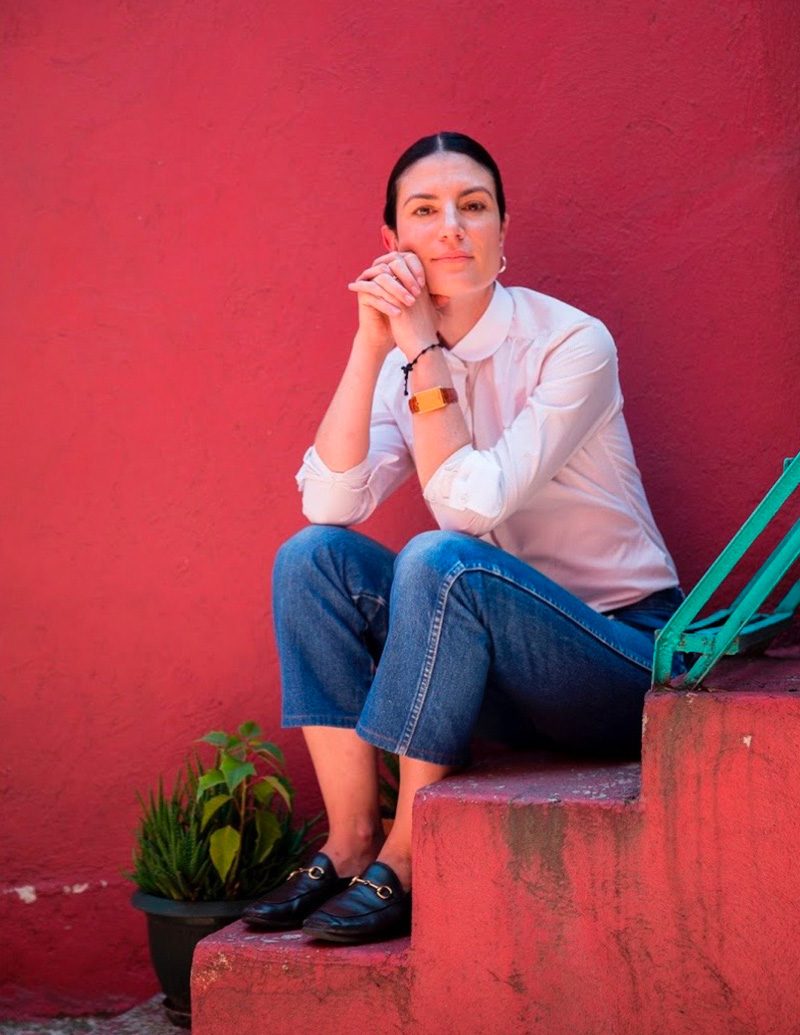
LATINNESS: You’ve been living in Mexico City for a few years now. How do you feel that move influenced you creatively?
OLIVIA: We moved here six months before COVID, so in August of 2019. On so many levels. I wouldn’t be doing what I’m doing if I wasn’t in Mexico. When I got here there was no agenda of starting a business or a line. I came here with my husband Guillaume who is from here and grew up here, and we’d been talking about moving to Mexico City.
We spent 18 years in New York, but I feel like every one of those years we were like, “Should we move to Mexico City?” It took us 18 years of flirting with the idea to finally do it.
It’s so cliché to say that there’s something incredibly creative in the environment and the atmosphere in Mexico City right now, but I also think it’s true.
LATINNESS: There always is, but it’s even more so now, isn’t it?
OLIVIA: Maybe there’s always been, it’s just more obvious now because of the digital culture.
The first time I came to Mexico City was in 2003, and I found the city so intimidating, I didn’t know where to begin. There are so many prolific artists and writers that’ve called Mexico City home in the past, but I think that it’s just become more apparent and easier to find than it was before. There’s something about it being a place with so much digital exposure that’s made it more accessible, even though all these things were already happening here.
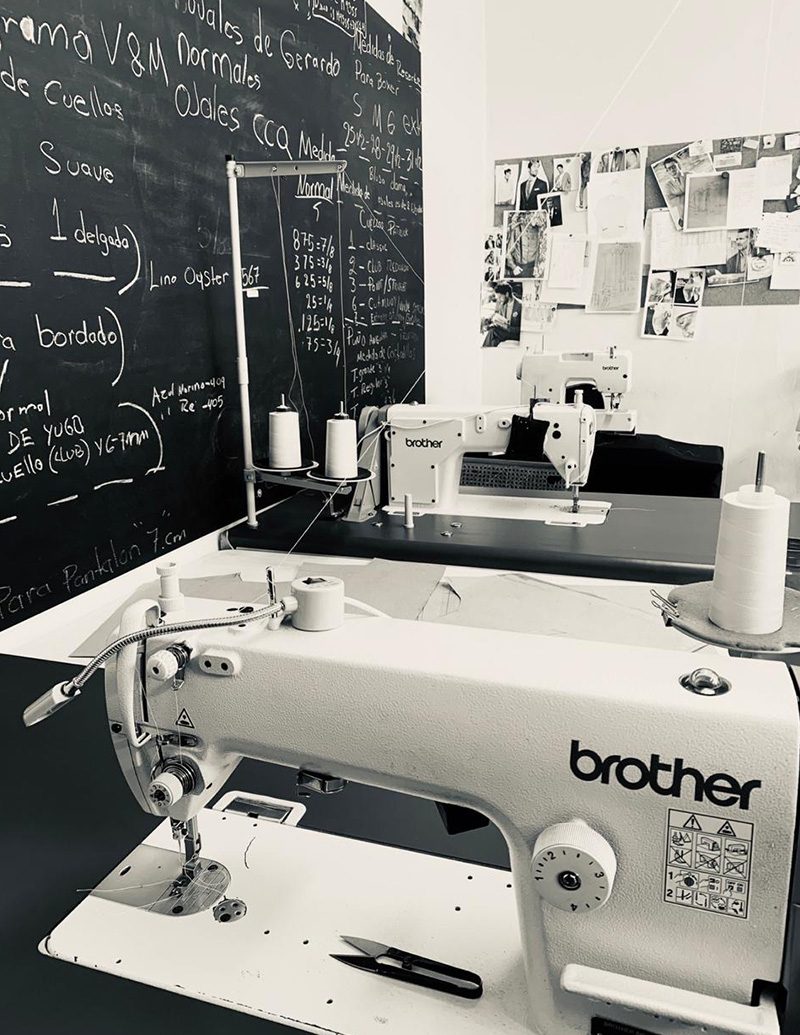
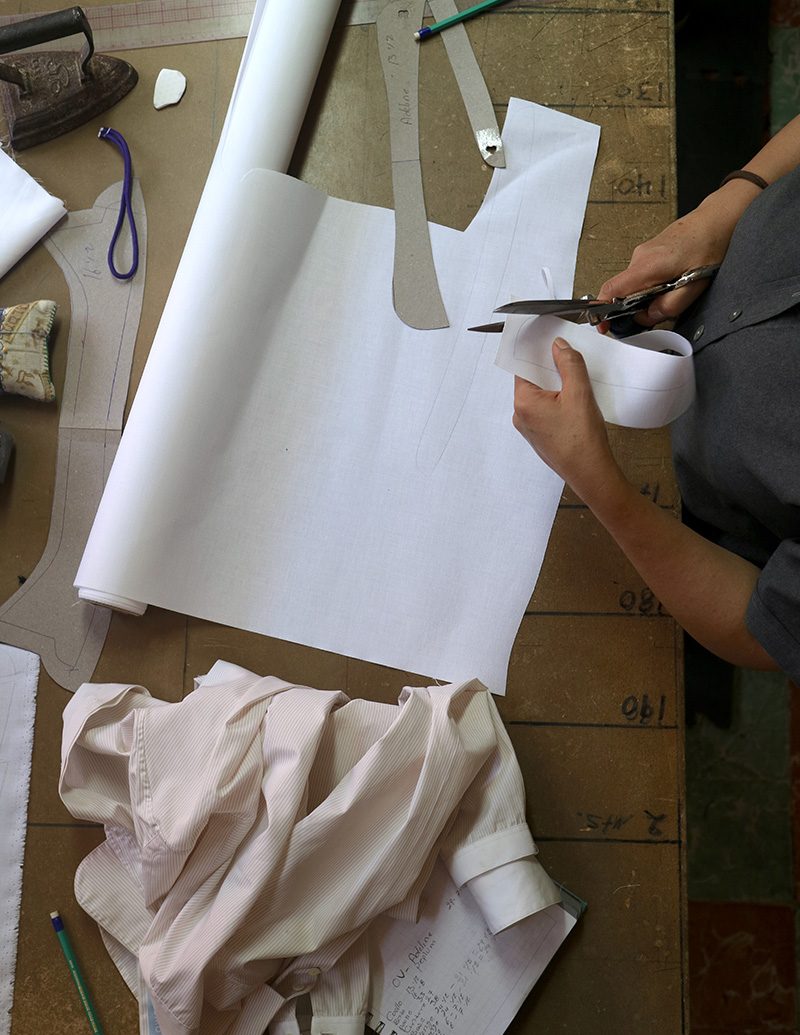
LATINNESS: Kind of like the studio you’re currently working from. Tell us more about it.
OLIVIA: Yes, my in-laws have been running this business, probably 50 years ago through my husband’s grandfather, and they had an infrastructure here that one could only dream of finding. They had a made to measure men’s shirting business and this incredible textile importation business. They have years of expertise in this field. That, in itself, opened this door to me.
It’s funny that you asked me earlier if I was a Virgo, because I do think that so much of the way that I work on Chava is in a very pragmatic, very Virgo-ilian brain way. There were just so many elements that could be played with that were already existent here, such as buttons that I had never even dreamed of finding. I immediately latched on to all the different collar options that the studio would offer their clients, and I was like, “What if we could make this a little more open? Or a little more spread? Or soften the inner lining so it falls in a more feminine way?”
I find I’m most creative when there is a ground to stand on. I love seeing a system, and then I love being able to mix the pieces up and find some sort of expression within something that feels established already. That was exactly what happened here.
The other piece of this was like, I’m enamored with the color and the beauty of the architecture and the design in Mexico City, and I feel like there’s something, in a funny way, that a really beautifully made shirt or a really beautifully made garment has. There is something almost architectural about the building of a garment, and I think that, if you were to see my moodboards, there are always architectural references. The use of lines and colors.
I started working on some linen designs for summer, and I’m really going bright. I’m so excited about it, but I feel like that’s really been inspired by what I’m seeing daily and surrounded by here.
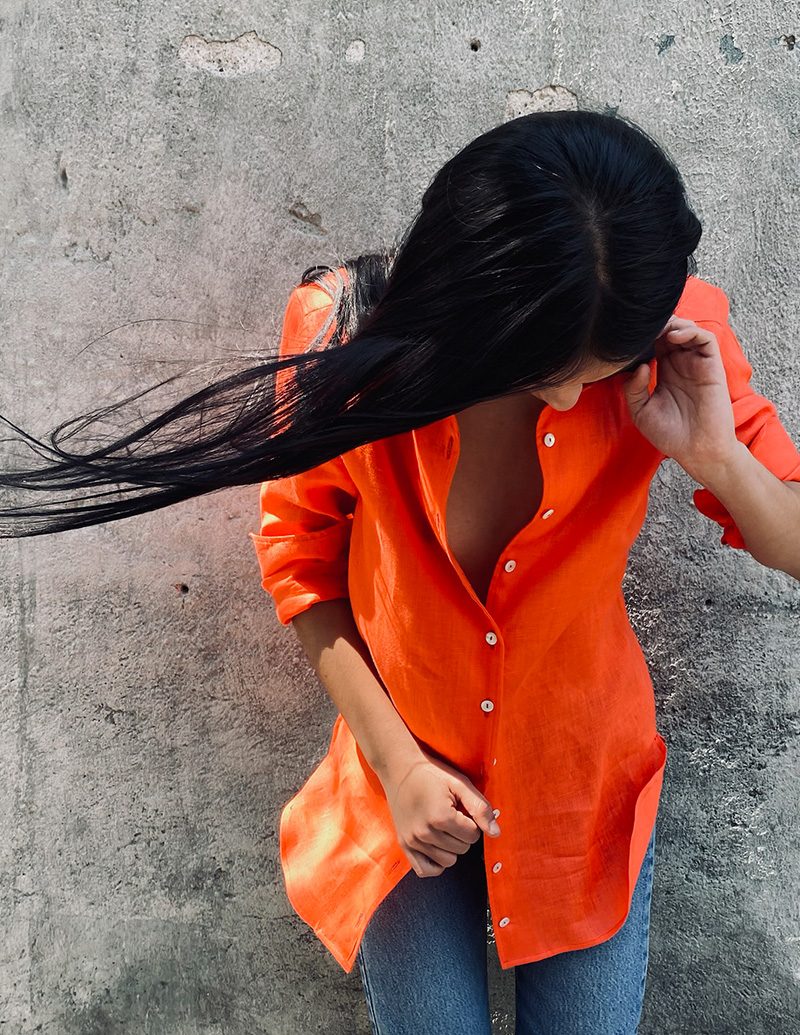
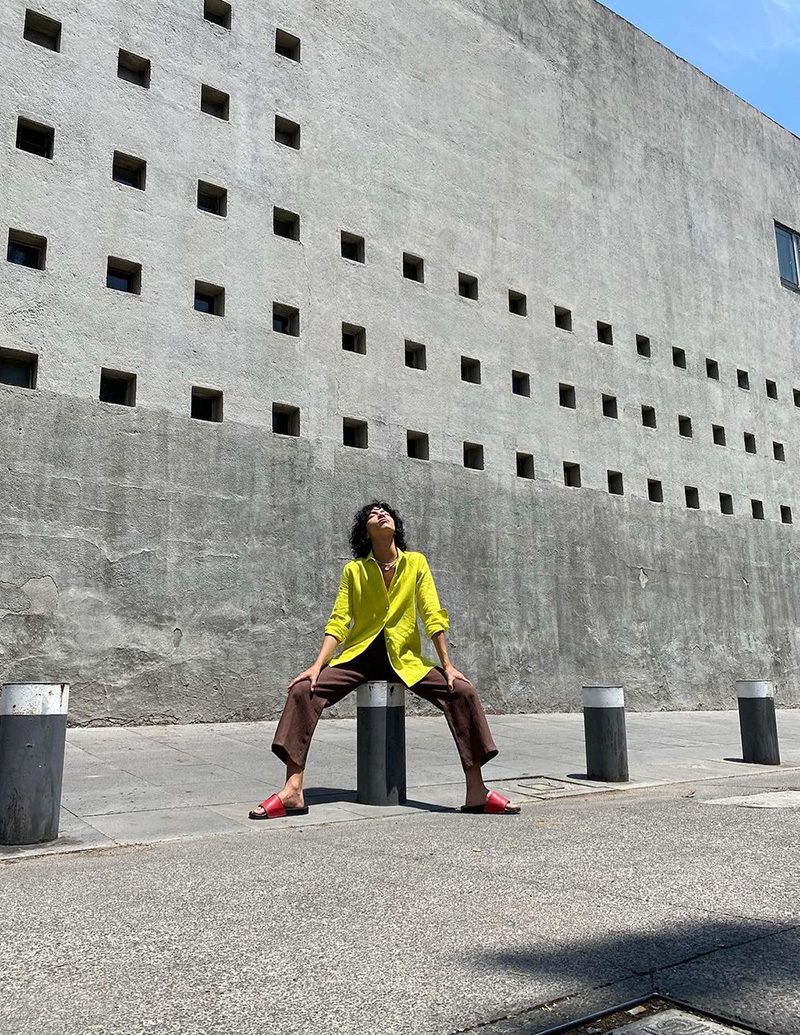
LATINNESS: This happened to me when living in Mexico as a foreigner, as well. We come in with an outside perspective and we appreciate local culture or the building on the corner differently than someone who grew up there. You bring in a new way of thinking.
OLIVIA: Yes, even our block, where our studio is located, is so interesting. Not many people know this area by name. My husband, who had been coming to the studio since he was a kid, didn’t really know what this neighborhood is called. This colonia in Mexico City is technically called Ampliación Daniel Garza, but this block is really interesting because it’s where (Luis) Barragan lived, it’s where the museum house is, it’s where he built a house for a partner, but then it’s also very much like a neighborhood.
Guillaume’s uncle knows all of the people on this block, and they’ve been living there for years. The use of architecture and color on this block… I’m looking out my window right now, and there’s this watermelon pink building with a green trim, and then our building is yellow, with this really beautiful, almost French blue accent. You could just walk down this one block and get so inspired.
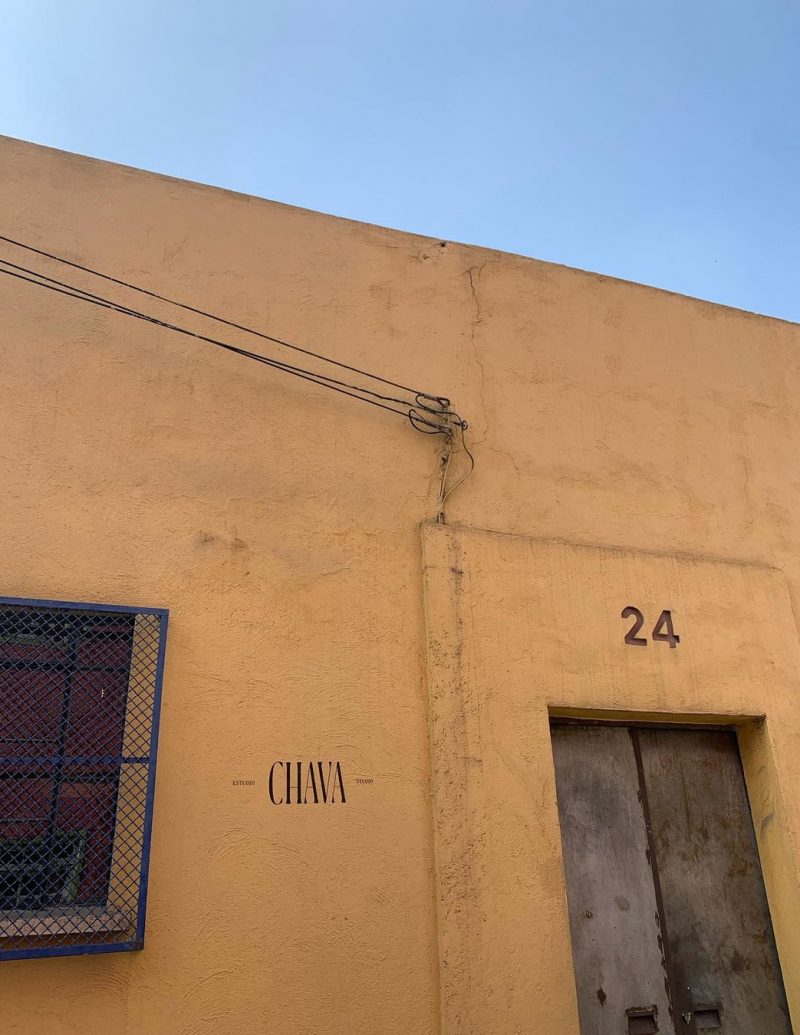
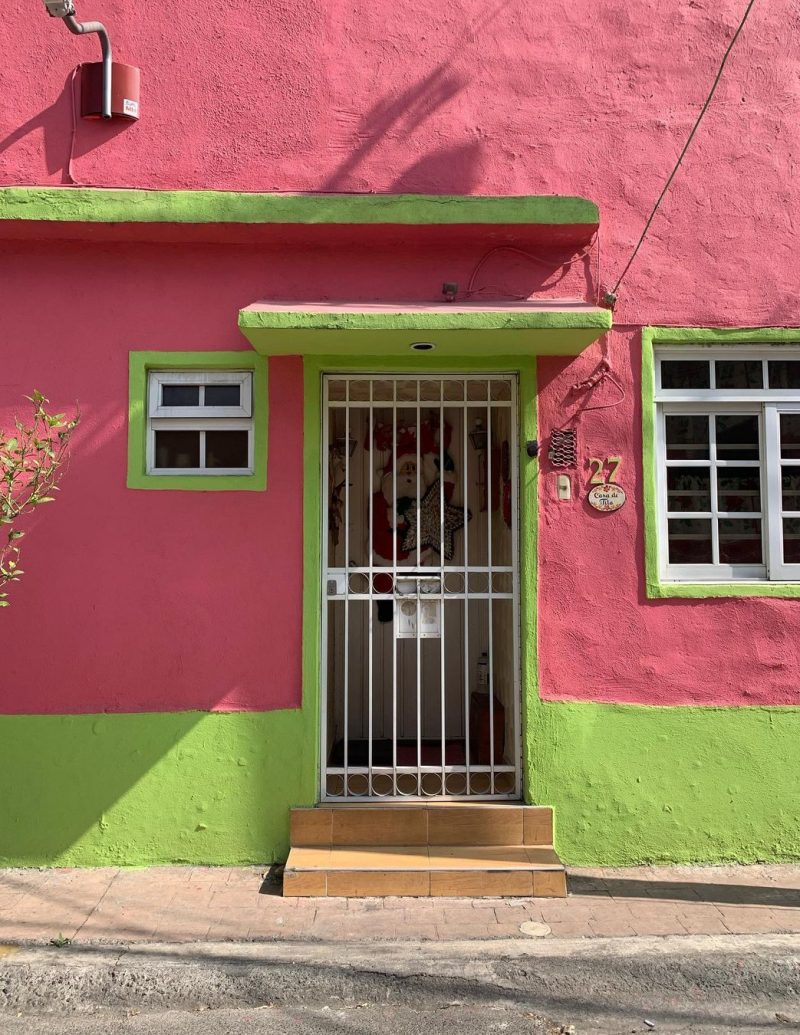
LATINNESS: So you essentially took over this family business. Was this something the family had intended to do eventually?
OLIVIA: Bruno is Guillaume’s uncle, who owns the studio now, and sometimes I ask him: “Do you regret this?”
A lot of the industry that they specialize in has changed dramatically because of fast fashion. There was a time when they had 15 different accounts of some of the best mills in the world: cottons, linens and crupos. They had a stronghold on that market, which is very niche and very specialty here in Mexico, but it was a totally different landscape then. Over half of those mills have gone out of business. It’s just the reality of so much industrialization in the world of fashion since the nineties. Everything has changed.
His grandfather worked in this business, but so did his grandmother. Her family founded a textile company. By the time she and her husband started working on this business, her family had sold theirs, but basically, it’s really in their blood.
When I moved here, Bruno was excited. He said to me: “Someone with just a little bit of creativity needs to come here, this is an oyster.” It’s a place that just needed a little bit of imagination and creativity, and I think he definitely saw that. I could never do this without him.
When I think about what we’re doing and what we’ve achieved with Chava, the growth and the reception of the brand has been so incredible, and none of this is possible without the support of Bruno. He’s been my guide through everything. There have been moments where it’s been a lot for us. We launched the brand in August 2020, and then we were featured in T Magazine in November of 2020. We were two months old, we had an insane amount of work and we hadn’t worked like that before. Especially our seamstresses.
Now that we’ve done this, there’s been this unlock, and our head seamstress is just so excited. This morning she was talking about this vision she had for one of our tuxedo shirts, and I think we’re just so engaged and there’s so much momentum.
I don’t think this was a plan. I don’t think Bruno was like: let’s start a business. During COVID, when everything shut down here in Mexico, it was really rough. For me, I lost quite a bit of my freelance clients. Of course, people weren’t really buying, nor were they getting made to measure shirts. It was just a really difficult time, and we really wanted to keep the seamstresses employed. So at that moment too, we were excited to start something that was like an experiment.
That’s the way it’s been with Chava to this day. I don’t have aggressive sales goals. We are in this really amazing position where we can make decisions based on what we feel we can do, what feels comfortable for us, and that’s a really nice position to be in. I never raised any money for this. I don’t have investors. Everything I did was with my own savings, and I think that takes away the pressure and the stress, especially when working with family.
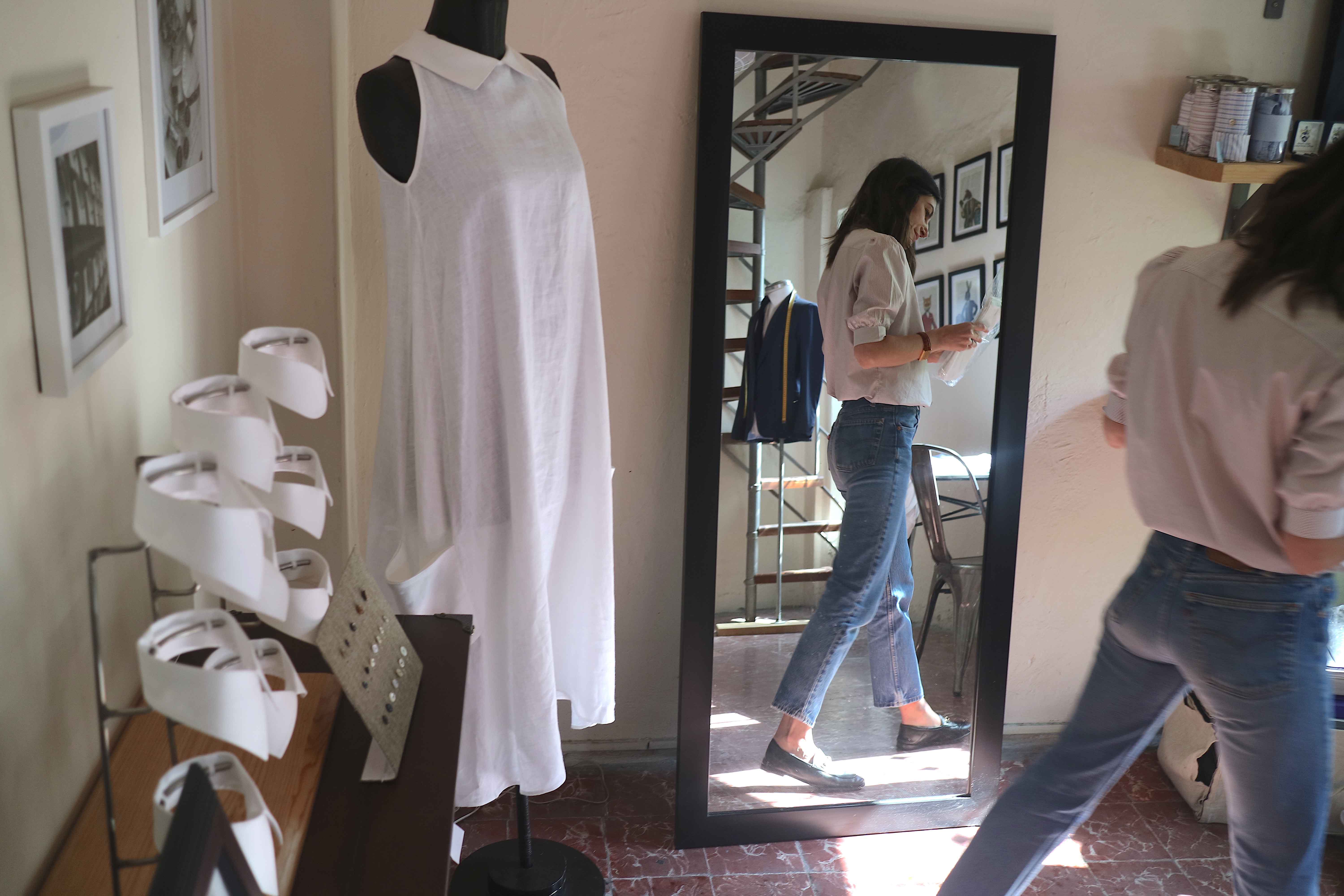
Bringing together established expertise with a fresh femenine perspective inside Chava Studio.
LATINNESS: You mentioned your freelance work. How do you feel your experience as a writer and an editor helped you throughout this process?
OLIVIA: I’m really lucky that I had the opportunity to work in every job I had before this. Each informed this and has made it possible. I actually don’t think that I could have succeeded in this, the way that we have, if I hadn’t had those experiences. Working in magazines helped me really start to hone an aesthetic and a style, and to be more tapped into the market in terms of how people were consuming products and content.
I started at Lucky, which was the ultimate consumer machine, so I started to understand that better. Then onto J. Crew and Madewell, and I really feel that working for those two brands was like getting an MBA. The way that Mickey (Drexler), who was CEO at the time, operated those businesses was by fully giving every department visibility, as much as possible, into what other departments were doing and how they were operating. There was always a constant dialogue around the business and what was happening.
Since I was on the editorial team, I would sit in meetings on the buys and on design meetings. A lot of the way that they treated the team was as if we were the journalists for the brand, so I learned so much. I was constantly learning about margins, about cost-control, about inventory, the liabilities of inventory, which is why we do made-to-order. I really feel like I got so much from those experiences that when I started Chava it was almost nice that I hadn’t been pegged into one specific facet of the industry.
As an entrepreneur, I’m literally a team of one, other than production, which Bruno handles. I’m doing everything from writing our newsletters to designing the collections, buying the fabric, shipping orders, everything. So I think I’m actually equipped for that. Not to say it doesn’t feel like a lot, because it often does. Sometimes I feel out of my league and overwhelmed, but simultaneously, I think that the only way I could’ve done this is through having those past experiences within the industry where I just was soaking up.

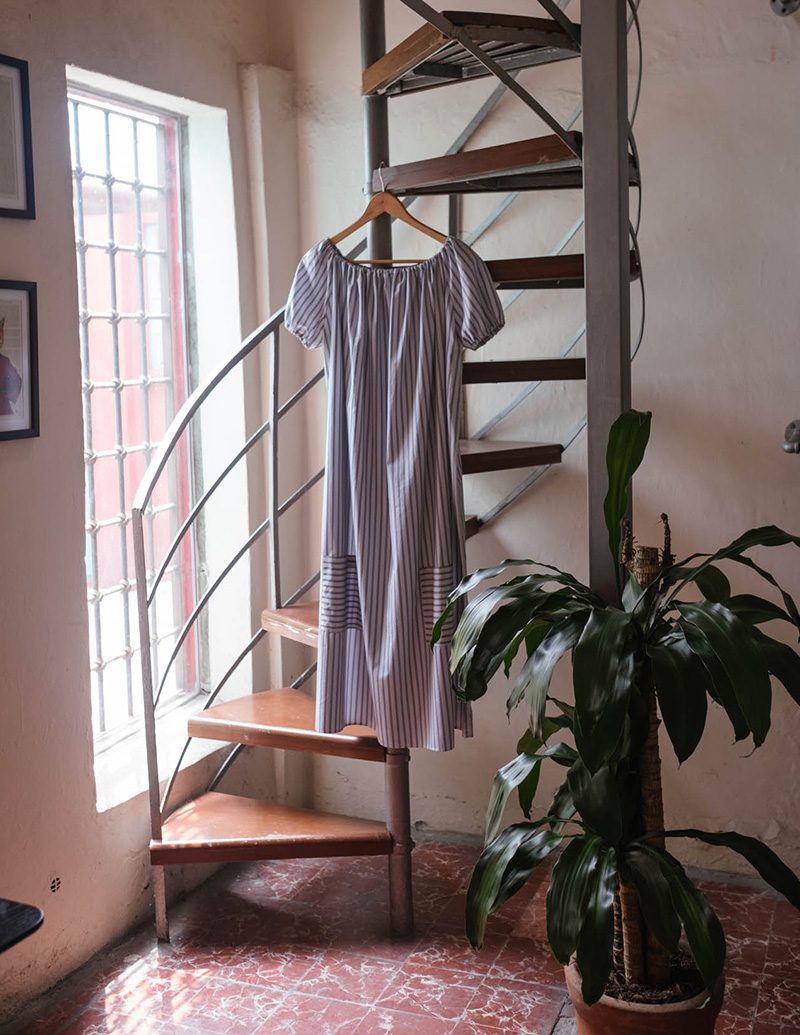
LATINNESS: How would you describe the ethos of Chava?
OLIVIA: I feel like we have this very ambitious thing that we’re trying to achieve, in a very small way. Chava, at its heart, will always be small, with a limit to how many items we can make. Yet our goal is to be a part of a shift in the way that we see the clothing that we own. It feels like over the past 20 years, we’ve really gotten away from valuing clothing. It feels very disposable, but when I started having my clothes made at the studio before Chava was even a business idea, everything felt so special, like I could never get rid of it.
The fabric feels so good, the tailoring so beautiful, I just can’t imagine a world in which this will not have value to me. This feels so special, and I think that, from an industry perspective, that’s what I’m craving. I was craving that when I got here, when I stopped working in-house for brands, because I felt like there’s something about the commoditization of fashion that just feels– maybe it’s my age, I’m 40 now– but it doesn’t feel right for me at this moment in time.
So at our core, I feel that’s part of our ethos. Then there are certain things we will never compromise on and every design is built on this. One is beautiful materials: we will not compromise on fabrics. I love the fabrics that we use. There’s a difference in the way it feels on your skin and the way it makes you feel.
Then, making sure that every piece feels wearable and has a timeless quality about it, but also feels emotional and special. It’s the blending of those two things because you can find a beautiful button-down that feels very basic and has a great place in your wardrobe, but we always try to give our designs something that really pulls you in and excites you. Yet also making sure it doesn’t feel like it’s going to have an expiration date– that’s a hard balance.
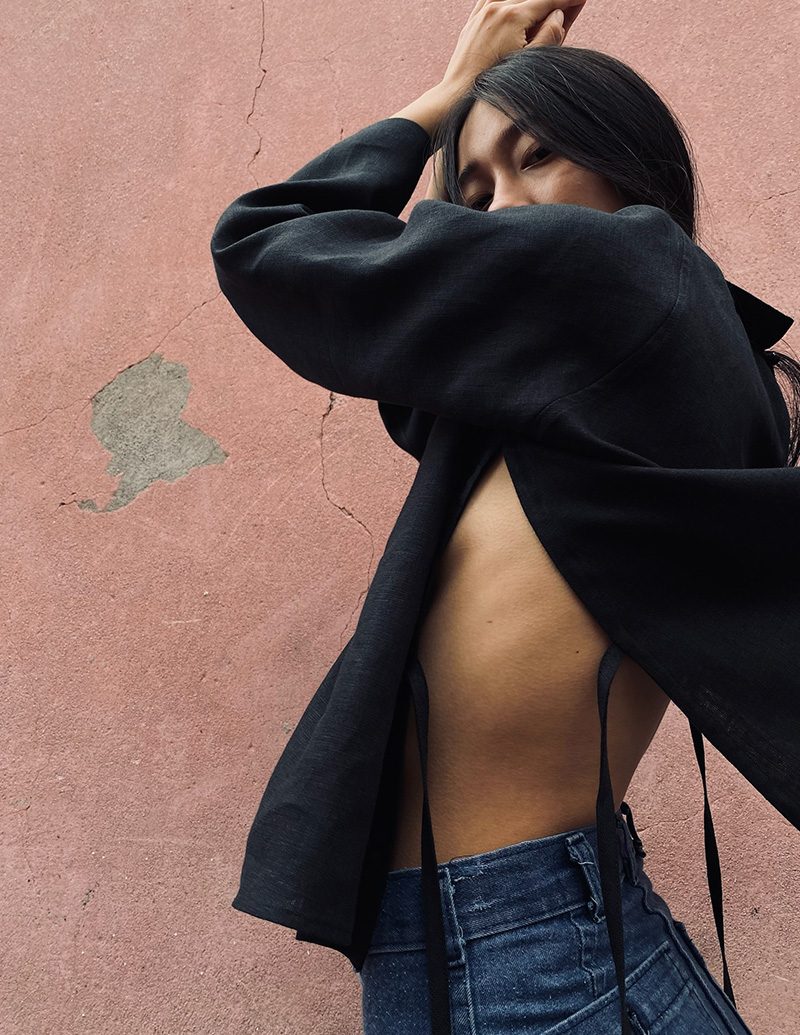
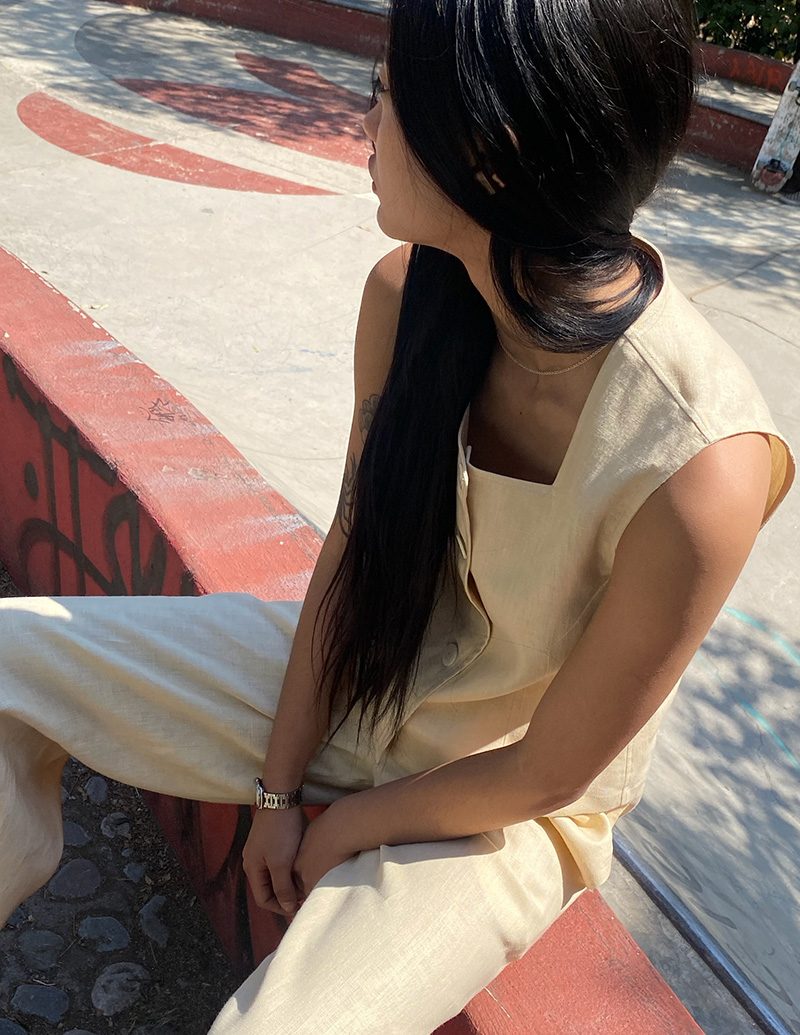
LATINNESS: It definitely is. How do you achieve that balance between creating basics and jumping on trends?
OLIVIA: I’m always kind of testing the waters, and I feel like there’s tension there because I also sometimes get excited about a trend. I like something that looks like it’s a ‘right now’ moment, but when I see those things or when I feel inspired by those things, I try to think: What is the Chava way of interpreting this?
It often harkens back to beautiful imagery, vintage, or resurrecting an idea. I like to think about how that idea played out in its original form.
We’re about to launch a pant, and I feel it has a timely silhouette– like a high rise, little linen, little kick flare– but the way I’ve been trying is almost like imagining these images of Carolyne Bessette on the beach, in Nantucket. How could you take this silhouette that feels very ‘right now’, and then make it feel like it has a place in 10 and 20 years from now?
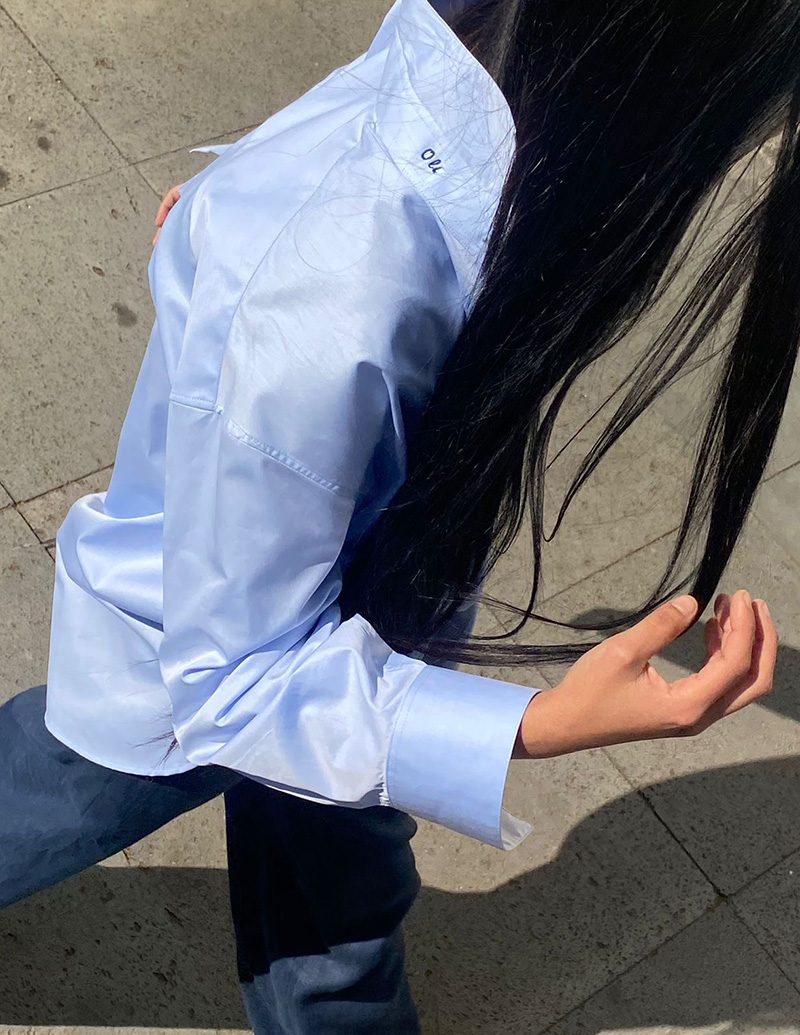
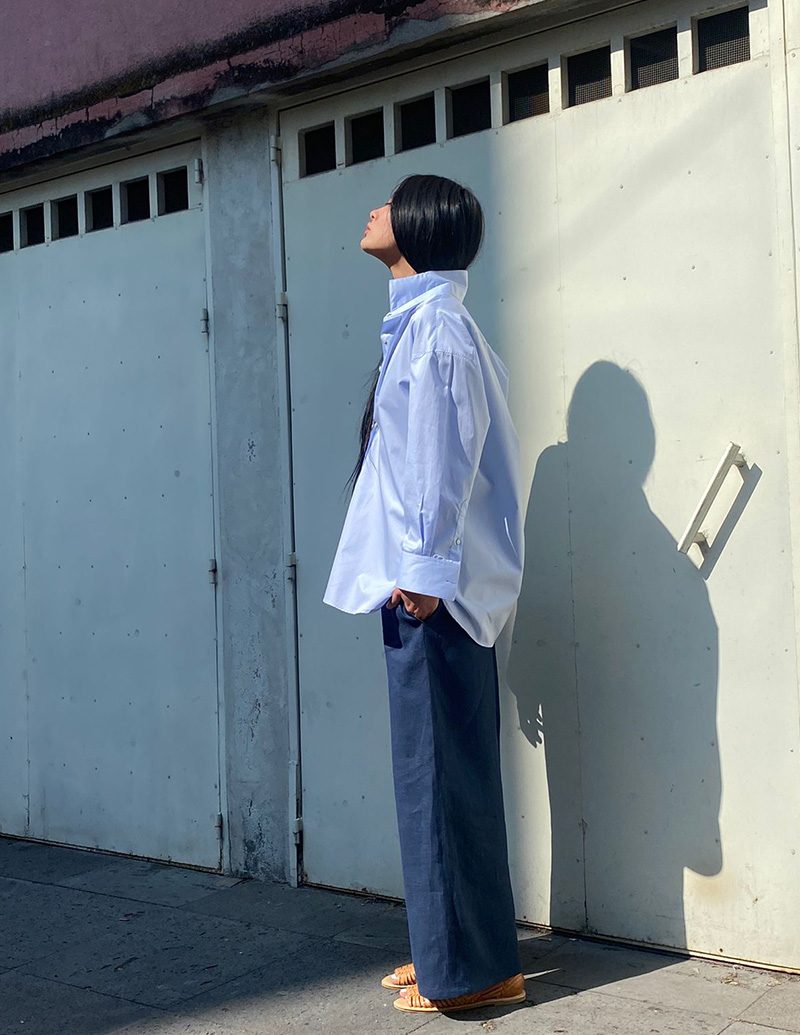
LATINNESS: You’ve put out two successful collaborations with photographer and influencer, Lucy Laucht, which I remember you told me sold out in record time. How did this come about?
OLIVIA: Lucy and I have been friends for a really long time. We met at J. Crew. One day, I was working with fabrics that I was considering buying from our supplier, which is a Swiss cotton company called Alumo, and there was one that was really light blue. I showed a picture of that on Instagram, and she responded like, “Oh my god, I’m dying for an oversized blue shirt in this type of fabric!” I offered to make one for her. When I started working on it and showing her pictures, we were like, “Should we maybe collaborate?”
So this is what I’ve been saying– everything has really started as an experiment. There isn’t an aggressive business agenda, which feels very safe and comfortable for us right now. We made the collaboration, and it sold like crazy. I think we sold out in three hours. I bought the fabric. It was an investment, but it sold out really fast. We just had such an amazing experience. She loved shooting the shirt, and created beautiful imagery at Cornwall, where she lives. After that, a few months later, she suggested we do another one in white.
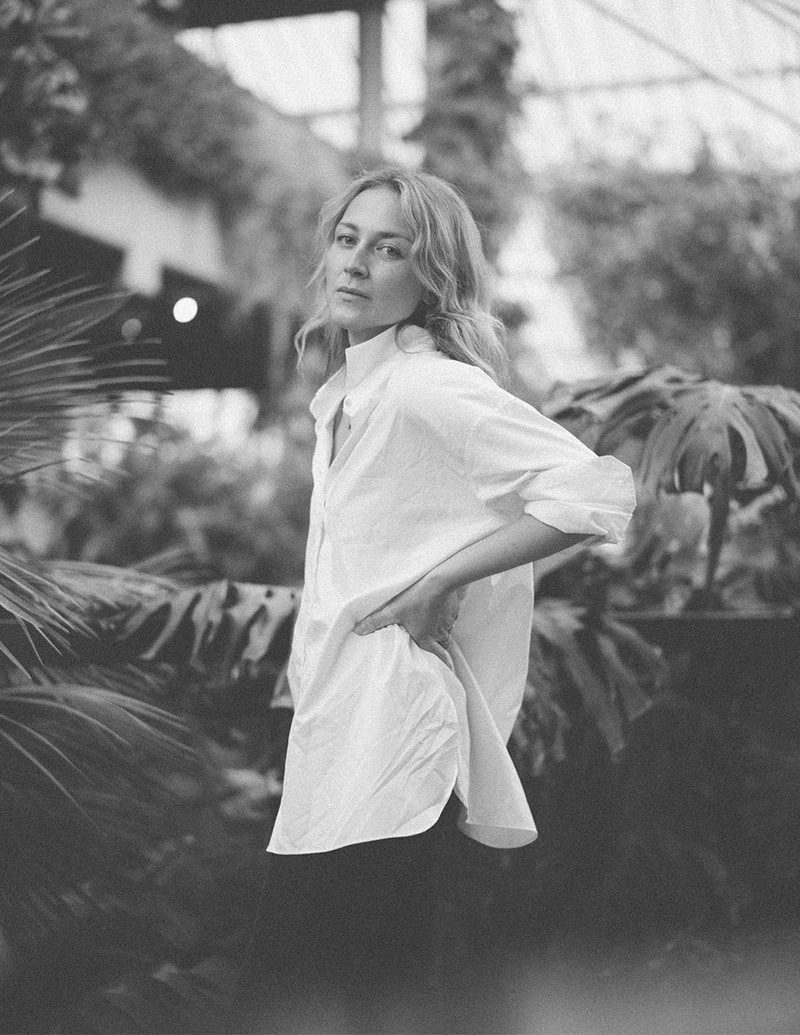
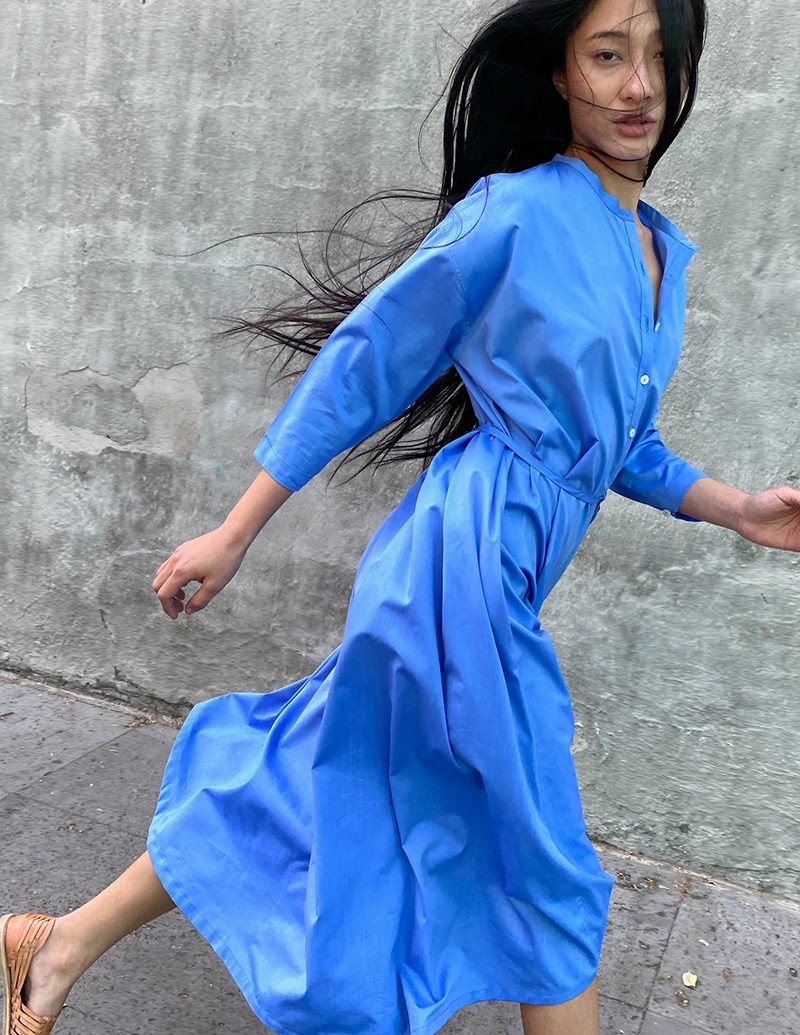
Dress made in collaboration with Sun Sinawi.
LATINNESS: Collaborations have been a great strategy for Chava.
OLIVIA: I also did one this past spring with my friend Sun Sinawi who owned my favorite boutique in Brooklyn, Pas Mal. She’s also a mom, and our sons are really good friends. We did a collaboration with her, and it helps me expand my mind a little bit and gets me out of a very contained headspace. I think for that reason, for our clients, it just feels very fresh and new for us. That’s why they tend to be such great sellers. This collaboration was also amazing. We sold out of that dress in a day, it’s crazy.
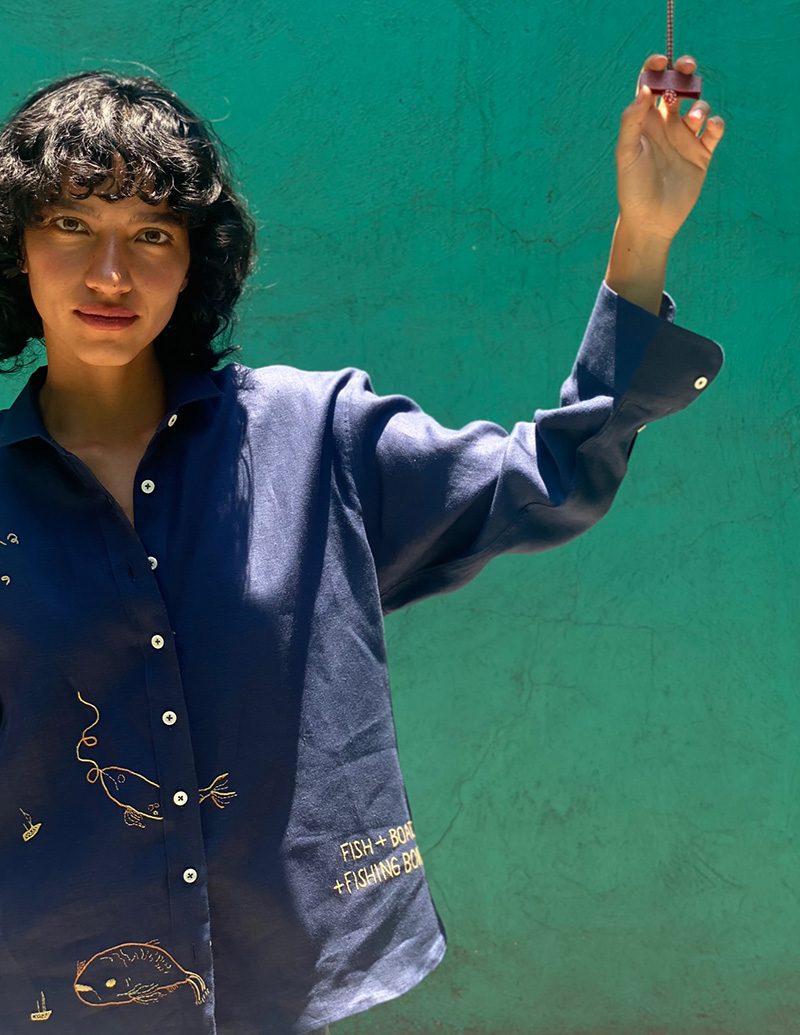
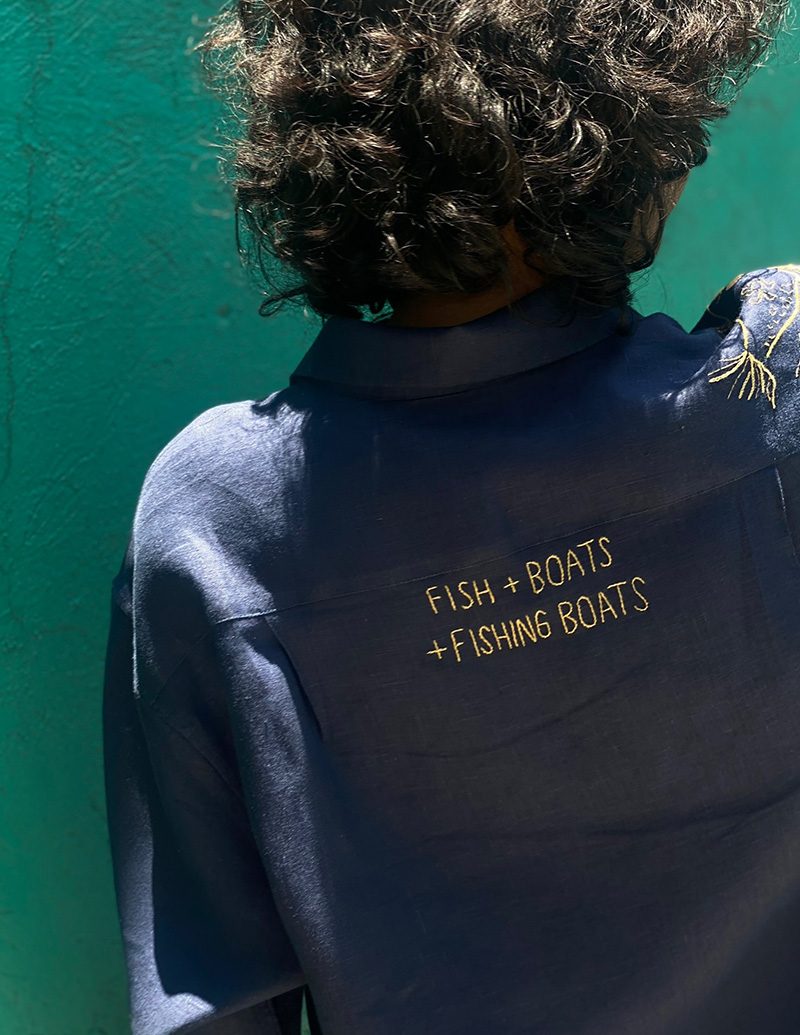
LATINNESS: You just launched one with Leandra Medine, as well.
OLIVIA: Leandra was a very early supporter of Chava. My first month, I DMed her, asking, “Can I make you a shirt?” She was immediately responsive, and said “Yes, absolutely. I love your shirts.” She asked me questions about the line, and there was something about her immediate interest, beyond just getting a free shirt. She was really engaging with me about the story of the line, so I immediately felt a connection through that.
I do think that a button-down feels like a very Leandra piece, so I always felt she was kind of like a Chava muse. Then we just became friends, and when I was in New York, we met a couple of times. I feel like beyond this, we’ve become actual good friends, which is key for me with collaborations. I really like working with friends.

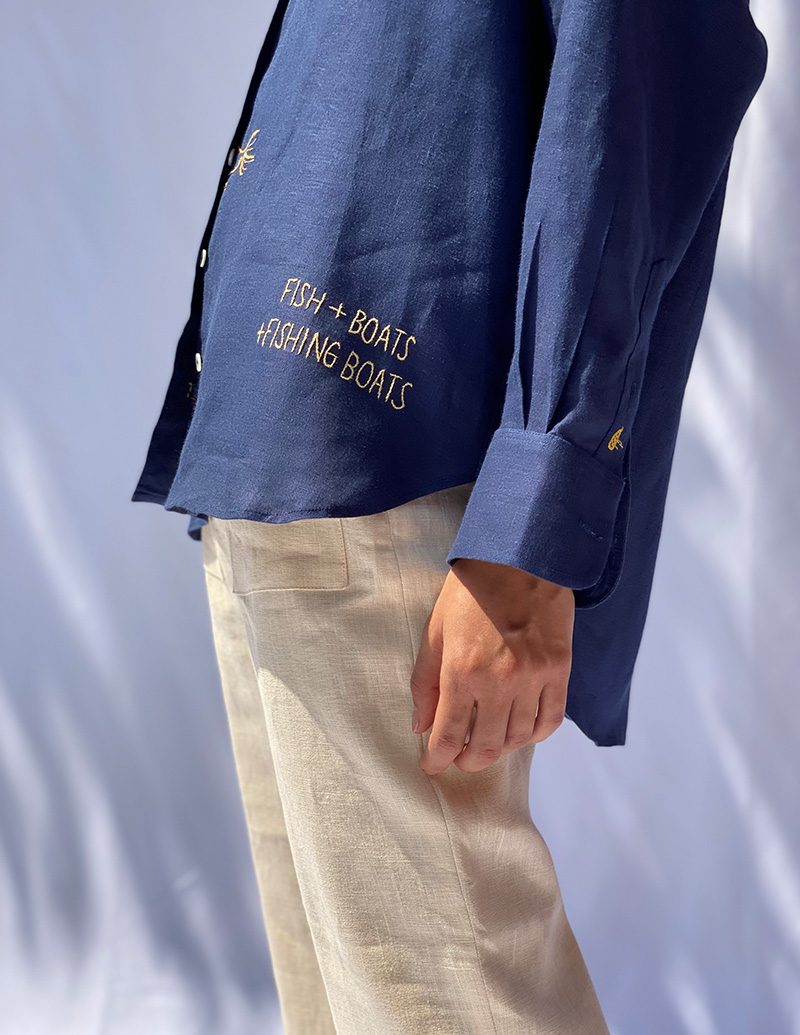

Details of the collaboration which included illustration by Antonia Alarcón and embroidery by Jauja Bordados.
LATINNESS: This piece was a bit different from the others. Can you tell us the backstory of the collaboration?
OLIVIA: We’d been talking about Chava, and she asked if I’d ever thought about embroidery. I’d thought about it, but I needed to make it happen. So she wanted to do embroidery, and I was like, “Yes, let’s do it.”
We both had COVID in January, and she was texting me some lines of themes she’d been thinking about. One of the lines was: Fish, boats and fishing boats. It was so simple, but recalled almost like Shel Silverstein from my childhood.
We worked with this Chilean artist who lives here in Mexico City. She’s an embroidery textile artist, as well as an illustrator, and her tapestries are literal works of art you can hang on your wall. Her name is Antonia Alarcón. She’s so talented and was an amazing partner in this.
She and I started with sketches. Her aesthetic is something that I just adore. I’d been following her instagram (@tramoya_) before we worked together, but this was something new and different for her.
Then, to apply the embroidery, we worked with this incredible collective of women based outside Toluca. It’s run by three young Mexican artists. It’s an amazing organization called Jauja, and they have such respect for the women that they work with. All of the women work from home and they don’t allow them to work for more than four hours a day because of the physical strain of embroidery.
In order to take pictures to document the process, I had to give a class to the women on finances, which was the most incredible experience to meet them and see their enthusiasm. I felt very lifted from that day. And the quality of the work is incredibly high. So all around, it has been one of the most rewarding experiences I’ve had.
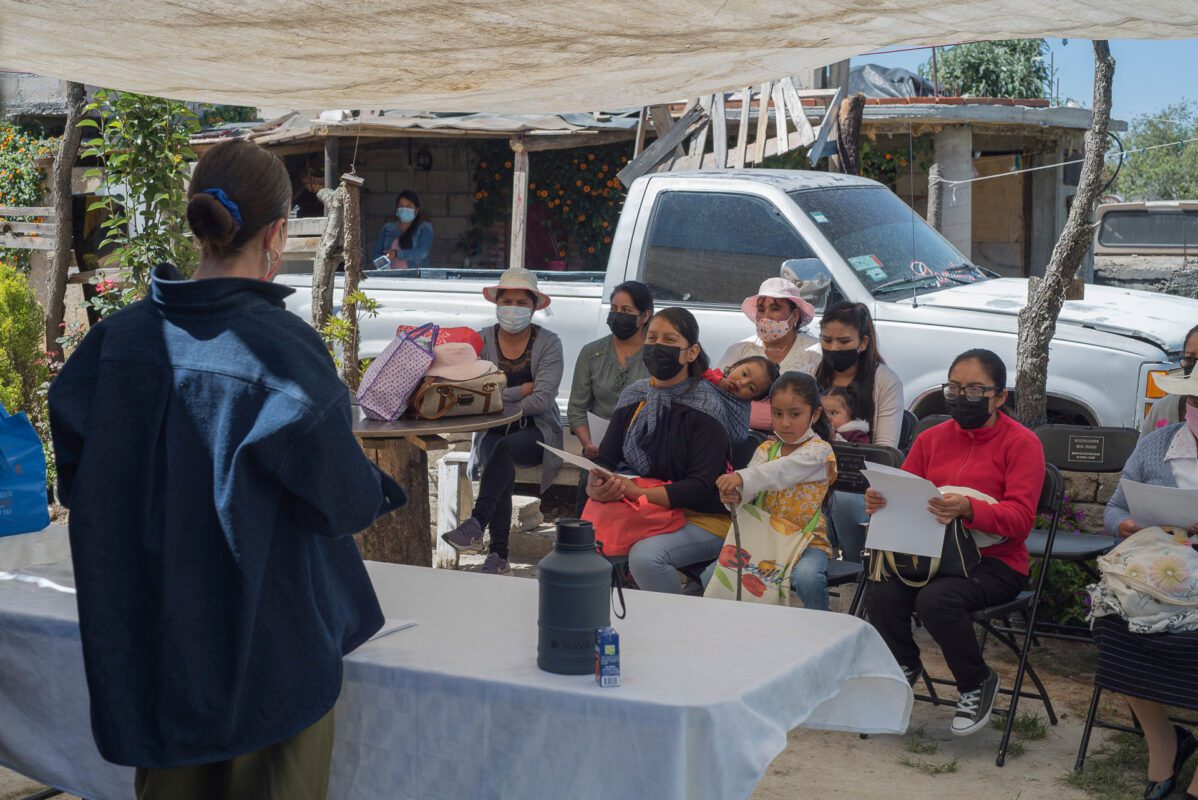
Olivia and the collective of women behind Jauja Bordados, in Toluca, Mexico.
LATINNESS: A true 360 degree collaboration.
OLIVIA: Honestly, the amount of people was such a new thing for me because I’ve been so insular. There were moments when I was having meltdowns because it was so hard to coordinate the timing. Deciding on an inventory of the shirt, for instance. We didn’t make these made to order because of the embroidery component. Logistically it wouldn’t have worked, so that was a whole other process.
So many new things came out of this. It’s been an incredibly rewarding collaboration, and now, I want to do more embroidery and continue working with Jauja because my experience with them was so incredible.
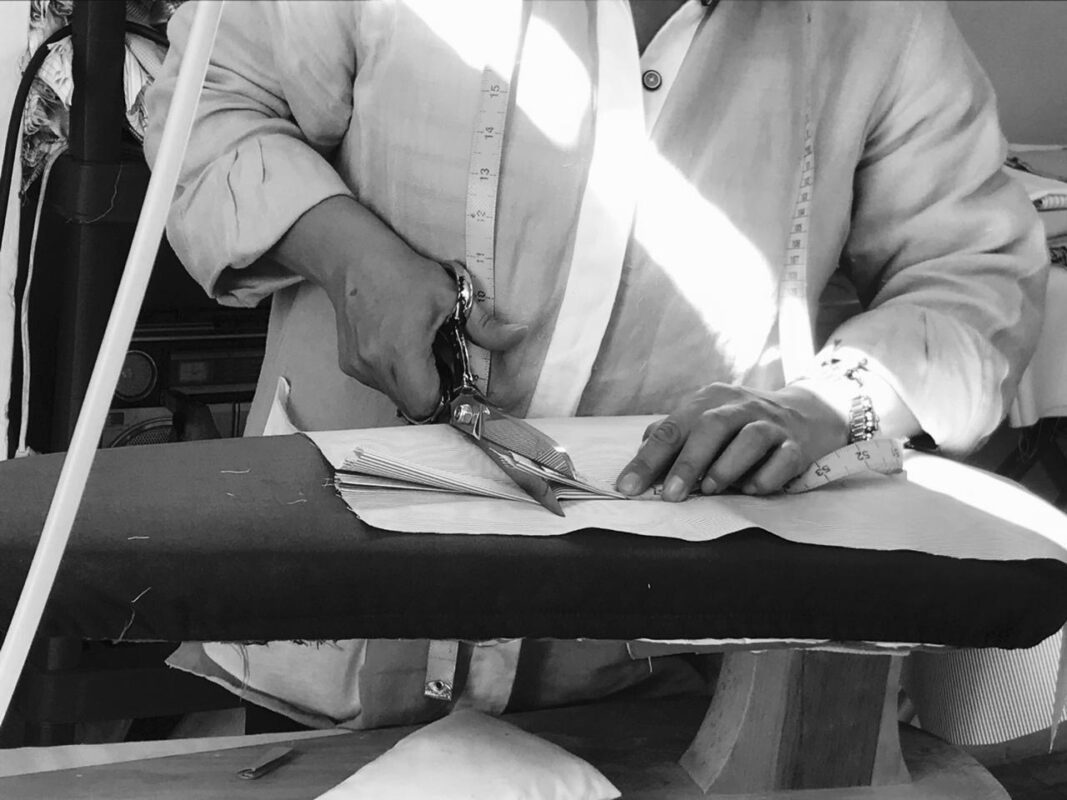
A seamstress working in the Mexico City based studio.
LATINNESS: Speaking of inventory, how do you manage this growth as a made to order label that initially set out to create only 10 pieces per week?
OLIVIA: We’ve definitely gone beyond 10 pieces a week now, but it happened very organically, while also keeping our seamstresses’ hours really reasonable. They get in at 10 AM and leave at 5 PM. On Fridays they leave at 3 PM to avoid traffic congestion in Mexico City. It’s really important to us that our seamstresses feel well taken care of. We’ve hired two additional seamstresses, so now we have 4, which is great.
There is always this balance between a made to measure option and then creating designs. Right now we have this oversized twill shirt that only comes in two sizes, and I don’t encourage people getting it made to measure because it’s actually not meant to fit properly. That shirt is selling really well, it’s one of our most popular shirts right now.
So because we’re dealing with a higher volume of orders, it’s easier for us to organize our workflow. For instance, if we have five of those shirts in a size small, we can cut them all together. It’s a much more efficient process than cutting everything one by one like we were doing in the beginning.
In terms of collaborations, all of the designs, like the Lucy shirts, were both very oversized. The dress we designed with Sun was very oversized, and then this shirt with Leandra is moderately oversized. It has a little cropped front and a longer back, but the fit is less precious. That also means that they’ve been amazing in terms of our workflow because we’re much more efficient when we’re cutting shirts that way.
I love that we offer made to measure, I love that people have that option, and I think it’s at the core of our business, but simultaneously, it’s also nice to have designs that don’t require a new pattern every time. What we do is very, very labor intensive, and when you have designs that don’t have that level of tweaking, it’s much easier on all of us. When I do collaborations, I try to not do a shirt that’s going to be offered in sizes 0 through 10 plus made to measure. It’s just not even a possibility for us. That would be the moment where Bruno would say: No, go home!
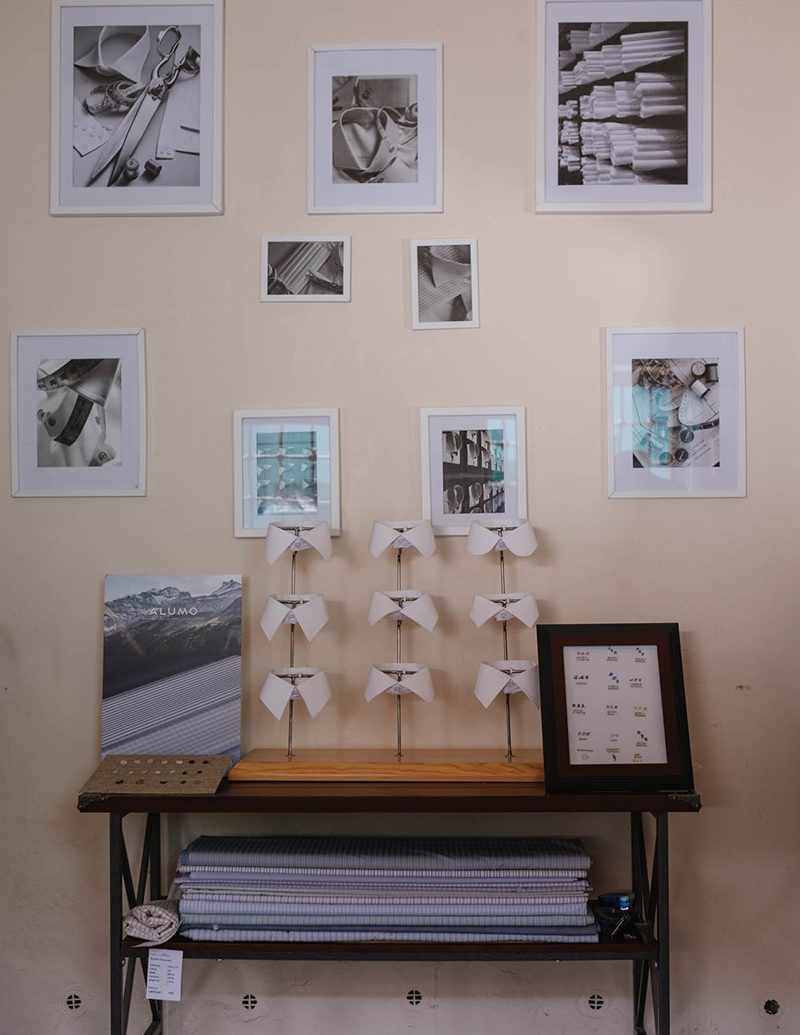
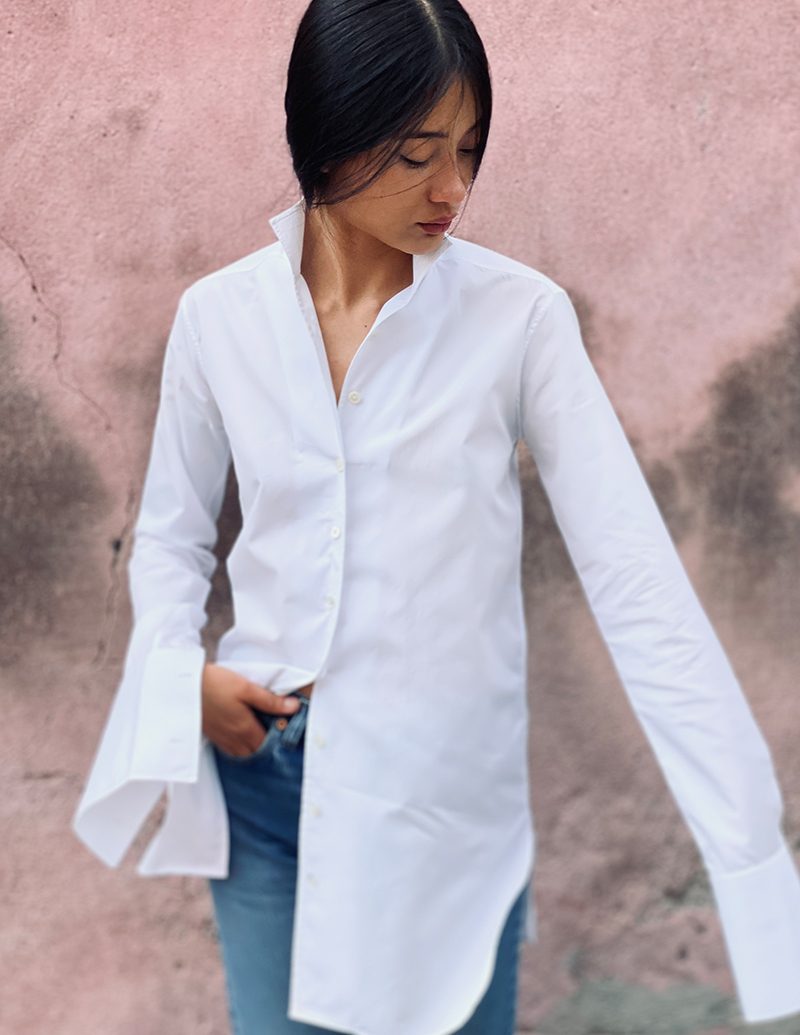
LATINNESS: Tell us about the name Chava?
OLIVIA: After years of naming things, because that was part of my job at Madewell and J. Crew, I’m loath to overthink naming. I think you can have a strong name, and oftentimes, it’s the first one that comes to your head.
The studio had been made to measure men’s shirting, obviously really masculine, and I felt like the sensibility of the line was a more feminine approach to shirting. While we do have male clients who order our shirts, I do think there is a void in the market in terms of women’s shirting to get the same level of detail and all these beautiful things that you can find in men’s shirting.
I wanted a name that referenced that, and I love Mexican slang. I lived in Barcelona and studied Spanish there. When I first started coming to Mexico, Guillaume was like, “You can’t talk like that, you need to learn how to speak like a Mexican.” So Chava feels like something that you hear a lot in Mexico. It really gets the sensibility behind the line and it’s a nice nod to our Mexican roots.
LATINNESS: When I moved to Mexico, I thought I spoke Spanish well, until I started going out with friends, and was so lost in conversations because I wasn’t well-versed in local slang yet.
OLIVIA: There’s almost this Italian way of using your hands to express, or there are certain gestures with a word, and if you’re not making a gesture with the word, it has less meaning than if you make the gesture. I love Mexican Spanish. There are words or expressions here that I always want to translate into English, and I can’t, and I think, “Why is English so basic?!”
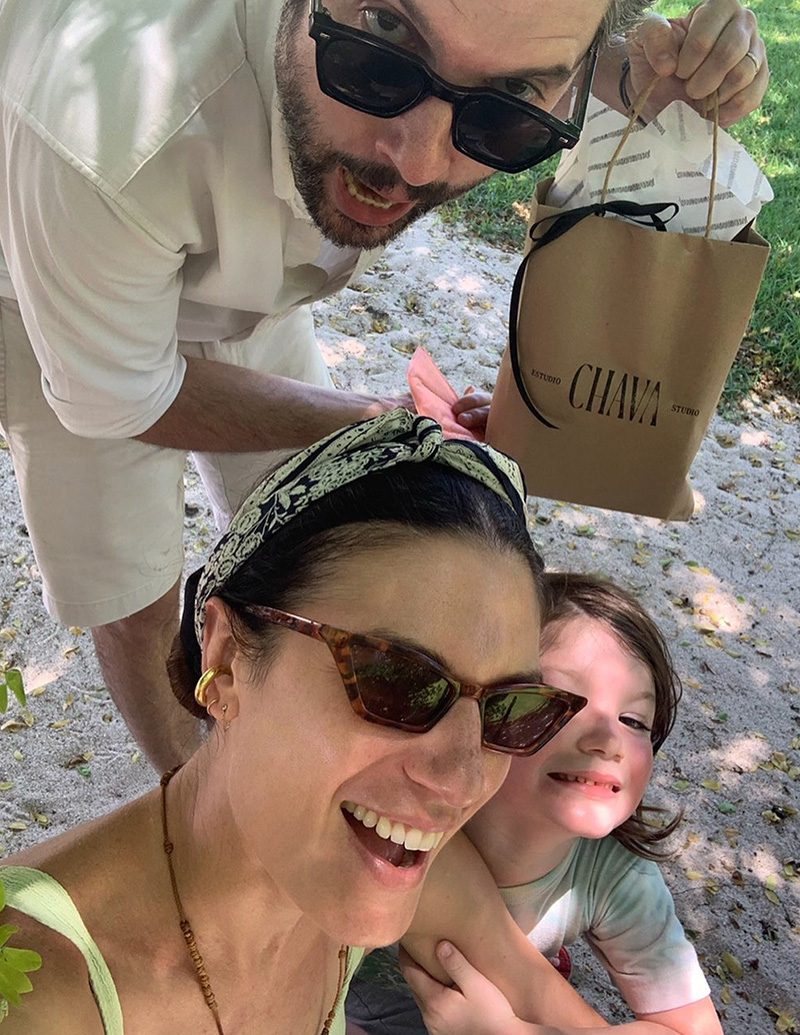
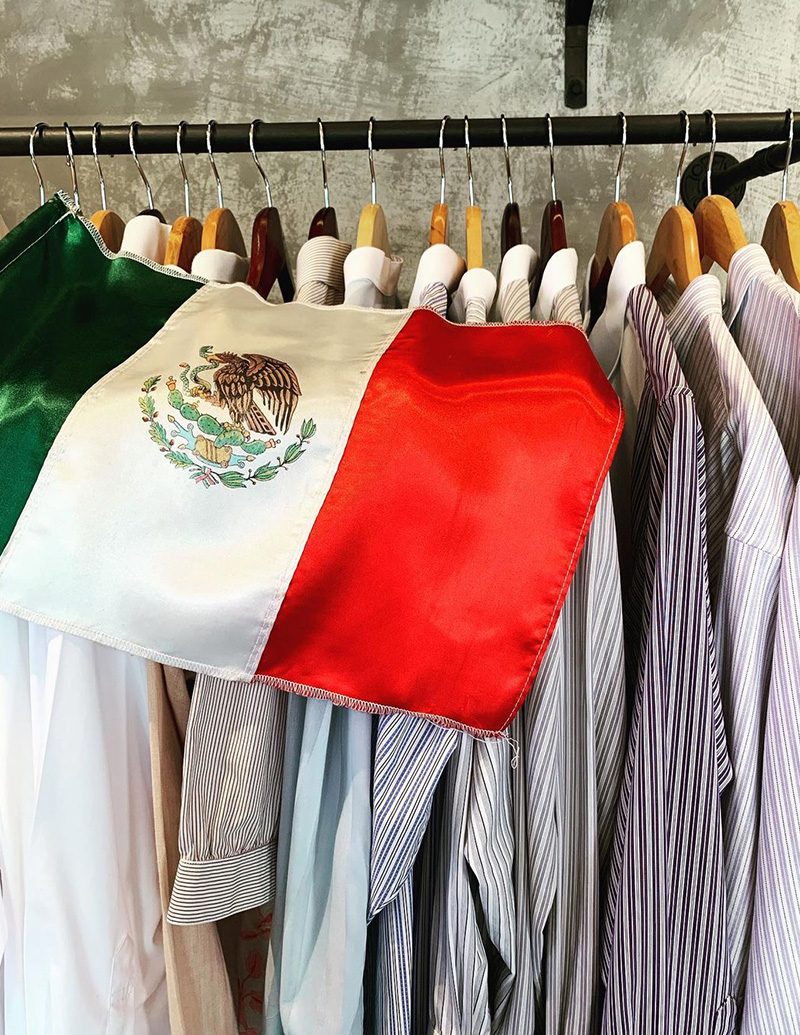
LATINNESS: What do you love the most about Latin culture?
OLIVIA: What we came here for, ultimately, and it’s proven to be so true, is the importance put on family. That was really something we were missing when we lived in New York. When we became parents, it felt like our life was almost two separate worlds. We had our son, and then we’d go out with friends or we went to work– everything was very compartmentalized.
What I love about our life in Mexico is that there’s a real embrace of mixing the two, of bringing your family into other parts of your life, and that, to me, feels really beautiful. That’s always how I wanted to raise my son.
Just making time for family, it’s also new for me. Truthfully, there’s been a learning curve. There have been moments when I’m like, “A comida on a Thursday? How are we going to do this?” But that’s what we’re here for, that’s what I love, and that feels really important, especially right now. When the world got really intense and kind of scary, having a connection with family is amazing.
Images courtesy of Chava Studio.


